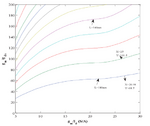melkord
Full Member level 3

Can we get valid output resistance from characterization using gm/Id method ?
I characterizeed my NMOS and PMOS by sweeping VGS. VDS is kept constant at 0.9V (half the VDD), VBS=0.
I plot rout vs gm, rout vs gmid and found out their result are different.
The value of rout from real circuit simulation are also different with that of any of those plots, given the same gm or gmid.
I conclude that the gm/Id method cannot be used to characterise rout. is it correct?
I characterizeed my NMOS and PMOS by sweeping VGS. VDS is kept constant at 0.9V (half the VDD), VBS=0.
I plot rout vs gm, rout vs gmid and found out their result are different.
The value of rout from real circuit simulation are also different with that of any of those plots, given the same gm or gmid.
I conclude that the gm/Id method cannot be used to characterise rout. is it correct?

